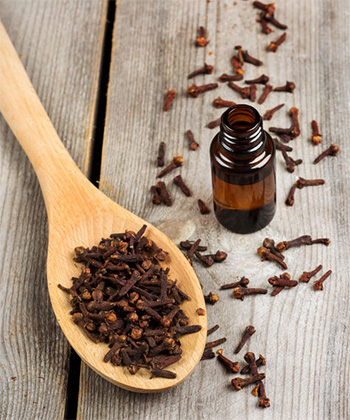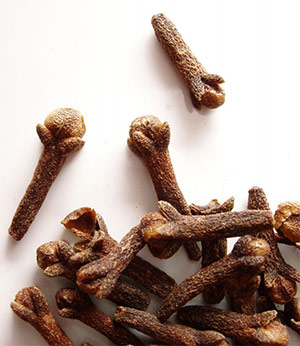Clove Bud Essential Oil
Syzygium aromaticum / Eugenia caryophyllata

Description
Usually when an essential oil is simply referred to as Clove Essential Oil, the oil pertains to essential oil distilled from the buds. However, it's best to always doublecheck with a supplier to confirm if the oil is indeed distilled from the buds or possibly the stems or leaves. This profile pertains to Clove Bud Essential Oil, except where otherwise noted.
Clove Bud Essential Oil is steam distilled from the flowering buds of the clove tree. Clove stem and clove leaf essential oils are also available, but essential oil distilled from the buds is generally favored due to its composition and aroma.
Clove Bud Essential Oil generally contains up to 85% Eugenol, a phenol that dramatically contributes to the oil's aroma, therapeutic properties, and safety precautions. Clove Bud Essential Oil is also comprised of a number of other constituents, particularly the sesquiterpene B-caryophyllene and the ester Eugenyl acetate.

Clove Essential Oil is very helpful for use in blends intended to help relieve pain. It is also a powerful anti-microbial essential oil. However, being referred to as an "anti-microbial" oil does not mean that it is capable of killing all forms of microbes, bacteria and viruses. For information and citations to some of the research that has been conducted on the specific anti-microbial activity of Clove Essential Oil, refer to The Complete Guide to Aromatherapy, Third Edition Volume 1 by Salvatore Battaglia.
Clove Essential Oil can be very irritating to the skin. Tisserand and Young recommend a dermal maximum of just 0.5%. (Please refer to the Safety Information section below for more information.)
Clove Oil is also known for its benefits in dental applications. It's often recommended for use with dental pain. Although numerous sources suggest applying a drop of Clove Essential Oil neat to a painful tooth, Clove Essential Oil is very potent and using it at full strength for any purpose is not recommended.
Aromatically, Clove Bud Essential Oil possesses a strong, warm, spicy aroma that blends well with other spicy essential oils like Cinnamon Bark. It also blends well with essential oils in the citrus, wood and floral families. It's a strong oil, so when first learning to blend with it, try using it sparingly in blends.

Emotionally, I find Clove Bud Essential Oil to be an invigorating and mentally stimulating essential oil. American College of Healthcare Sciences principal Dorene Petersen has undertaken research regarding cognitive and brain health. She presents that Clove Bud Essential Oil shows promise for assisting in the management of neurodegenerative diseases. [Dorene Petersen, Presentation: Clinical Use of Aromatherapy for Brain Health: 7 Essential Oils. August 9, 2017, New Brunswick, NJ. Alliance of International Aromatherapists 2017 Conference. AIA 2017 Conference Proceedings page 221-222.]

Robbi Zeck offers a nice profile for Clove Bud Essential Oil and mentions that "Clove Bud heightens inner strengths when external and internal environments need to change." [Robbi Zeck, ND, The Blossoming Heart: Aromatherapy for Healing and Transformation (Victoria, Australia: Aroma Tours, 2008), 74.]
Clove Essential Oil Benefits and Uses
Cognitive support and brain health. Source: Dorene Petersen, Presentation: Clinical Use of Aromatherapy for Brain Health: 7 Essential Oils. August 9, 2017, New Brunswick, NJ. Alliance of International Aromatherapists 2017 Conference. AIA 2017 Conference Proceedings page 221-222.
- Pain Relief
- Bacterial Infection
- Fungal Infection
- Viral Skin Infection
- Warts
- Verrucas
- Toothache
- Gum Disease
- Muscle Pain
- Rheumatism
- Flu
- Bronchitis
- Tired Limbs
- Nausea
- Flatulence
- Stomach Cramp
- Abdominal Spasm
- Parasitic
- Infection
- Scabies
- Ringworm
Source: Valerie Ann Worwood, The Complete Book of Essential Oils and Aromatherapy, 25th Anniversary Edition (Novato, CA: New World Library, 2016, 581.
Botanical Name
Syzygium aromaticum / Eugenia caryophyllata
Plant Family
Common Method of Extraction
Steam Distilled
Plant Part Typically Used
Color
Pale Yellow
Consistency
Medium
Perfumery Note
Middle
Strength of Initial Aroma
Strong
Aromatic Description
Clove Bud Essential Oil smells spicy, warming yet slightly bitter. It is also slightly woody in character and is reminiscent in aroma to that of true clove buds but is of course much stronger in aroma.
Major Constituents
- Eugenol
- B-Caryophyllene
- Eugenyl Acetate
- a-Caryophyllene
- Isoeugenol
- Methyleugenol
Source: K.H. Kubeczka, Essential Oils Analysis by Capillary Gas Chromatography and Carbon-13 NMR Spectoroscopy, Second Edition. (Chichester: Wiley, 2002). B.M. Lawrence, Essential Oils 1979-1980 (Wheaton: Allured Publishing, 1981), 33-34. B.M. Lawrence, Essential Oils 1988-1991 (Wheaton: Allured Publishing, 1993), 36. Sources cited in Robert Tisserand and Rodney Young, Essential Oil Safety (Second Edition. United Kingdom: Churchill Livingstone Elsevier, 2014), 254.
Clove Bud Essential Oil Safety Information
Tisserand and Young indicate that when using Clove Bud Oil, there is moderate risk for mucous membrane irritation, may inhibit blood clotting and pose a drug interaction hazard. It may cause embryotoxicity. There is a moderate risk of skin sensitization, and Tisserand and Young recommend a dermal maximum of 0.5%. They advise not to use topically on children age 2 or younger. Reading Tisserand and Young's full profile is recommended. [Robert Tisserand and Rodney Young, Essential Oil Safety (Second Edition. United Kingdom: Churchill Livingstone Elsevier, 2014), 255.]
This essential oil poses a higher risk of causing irritation and sensitization when used in the bath. Avoid using it in the bath, even if it is solubilized/diluted.
Clove Bud CO2 Supercritical Select Extract
In addition to being available as an essential oil, this botanical is available from a small number of reputable sources as a CO2 extract. CO2 extracts offer many advantages. However, they can have differing safety precautions than essential oils because the natural chemistry of CO2 extracts can differ from their essential oil counterparts. Not much safety information is documented from trusted sources for CO2 extracts. Use CO2 extracts with great care and do not assume that every CO2 extract has the same safety precautions as its essential oil counterpart.
General Safety Information
Do not take any oils internally and do not apply undiluted essential oils, absolutes, CO2s or other concentrated essences onto the skin without advanced essential oil knowledge or consultation from a qualified aromatherapy practitioner. For general dilution information, read AromaWeb's Guide to Diluting Essential Oils. If you are pregnant, epileptic, have liver damage, have cancer, or have any other medical problem, use oils only under the proper guidance of a qualified aromatherapy practitioner. Use extreme caution when using oils with children and be sure to first read the recommended dilution ratios for children. Consult a qualified aromatherapy practitioner before using oils with children, the elderly, if you have medical issues or are taking medications. Before using this or any essential oil, carefully read AromaWeb's Essential Oil Safety Information page. For in-depth information on oil safety issues, read Essential Oil Safety by Robert Tisserand and Rodney Young.
Shelf Life
Important Information About the Profiles
The essential oil information provided on AromaWeb is intended for basic educational purposes only. The references to safety information, test results, constituents and percentages is generalized information. Essential oils can vary greatly in composition. The data is not necessary complete and is not guaranteed to be accurate. The essential oil photos are intended to represent the typical and approximate color of each essential oil. However, essential oil composition and color can vary based on harvesting, distillation, age of the essential oil and other factors. Profiles for several CO2 Extracts and absolutes are included within the directory, and are denoted as such.
